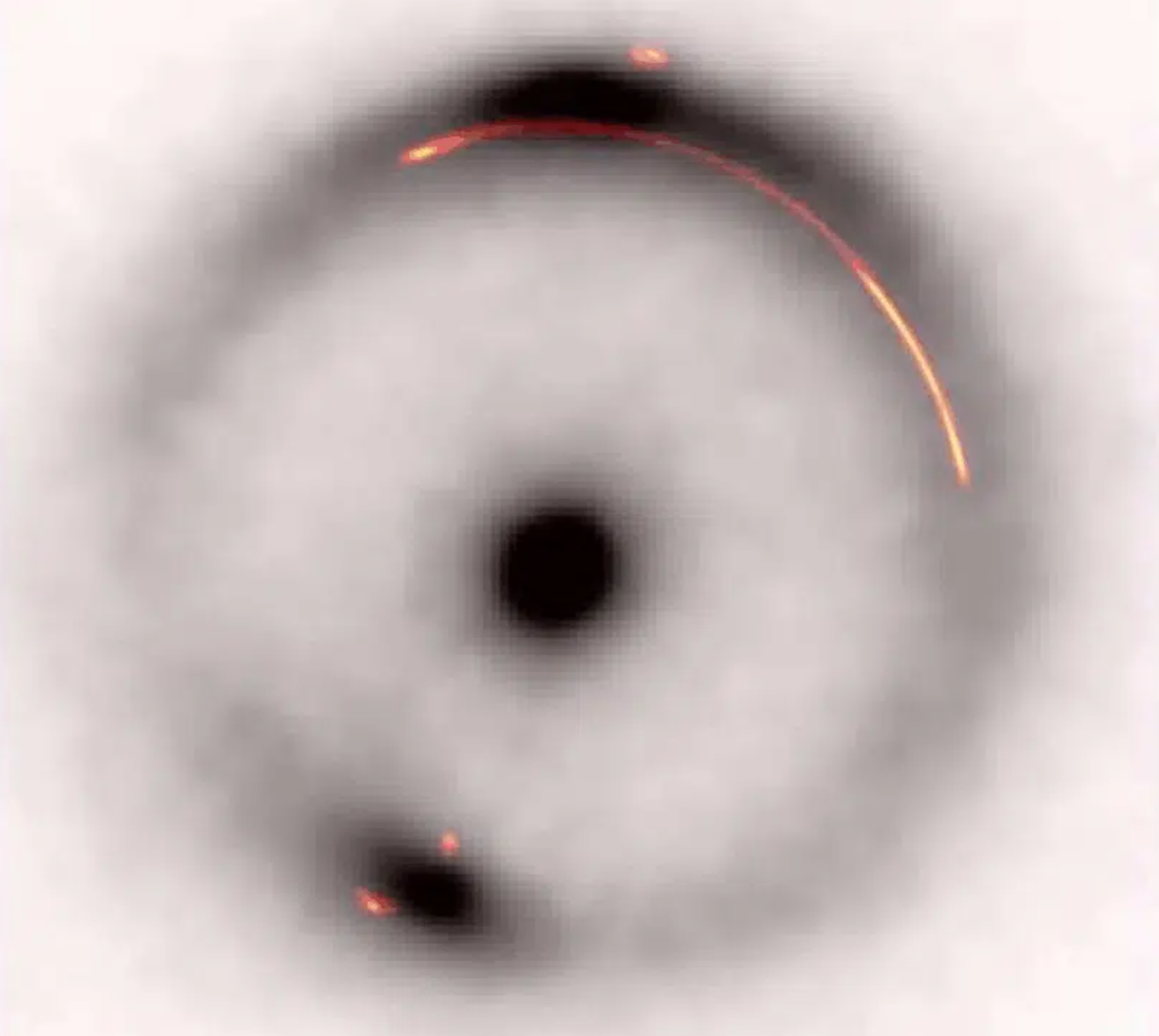Astronomers detect million-solar-mass object in distant universe
Astronomers detect the smallest known dark object ever found, revealing new clues about dark matter’s mysterious nature.

The black ring and central dot show infrared image of a distant galaxy distorted by a gravitation lens. (CREDIT: Devon Powell, Max Planck Institute for Astrophysics)
Astronomers have detected one of the darkest objects ever seen at a record cosmic distance—only with the assistance of gravity. The discovery is an important step toward the observation of dark matter and the confirmation of the underlying principles of the formation of galaxies.
The Smallest Cosmic Shadow Ever Detected
The object, nicknamed 𝒱, weighs approximately a million times the weight of our Sun—some 100 times lower in mass than any dark object ever detected through the method of gravitational lensing. But it's billions of light-years away, a record for the lowest-mass structure ever observed at such gigantic distances.
It emits neither light nor other forms of radiation. Its presence was, however, made evident through the way it warped the light of a background galaxy behind it—a tiny flaw warping the reflection in a funhouse mirror.
"It's an impressive accomplishment to be able to see something that is so low-mass so far away from us," University of California, Davis physics and astronomy professor Chris Fassnacht and co-author of the paper said. "Detection of objects such as this low-mass object is valuable to knowing the nature of dark matter."
A Window into the Dark Universe
The majority of what constitutes the universe is not visible. Dark matter—a form of matter that isn't detectable because it doesn't emit or absorb light—comprises a quarter of the universe. Astronomers think it's the invisible scaffolding that gives galaxies and cosmic structure their shape. But exactly what dark matter is, or whether it can coalesce into small, starless clumps, is one of the biggest mysteries in science.
Until now, astronomers could find low-mass objects, such as dwarf galaxies or star clusters, quite near to the Earth. Detection of such weak masses at a large distance was practically hopeless—until global teams began using gravitational lensing, where massive galaxies bend the light from objects behind them.
In this case, a distant galaxy called JVAS B1938+666 was the "lens." Its gravity distorts light from yet farther-away background galaxy into arcs and multiple images. Using high-resolution radio data, scientists found a tiny wrinkle in one of them—a faint "pinch" caused by much less massive unseen mass concealed within the lens galaxy.
Breaking New Ground in Gravitational Imaging
In order to identify something that was dim, scientists had to cause the entire Earth to behave like a telescope. They connected radio signals from telescopes all around the globe—to form a technique called Very Long Baseline Interferometry (VLBI). It consisted of the Green Bank Telescope in West Virginia, the Very Long Baseline Array in Hawaiʻi, and radio telescopes in Europe, Asia, South Africa, and Puerto Rico. In collaboration, they reached the precision to detect distortions that were less than a thousandth of an arcsecond.
"High sensitivity for our data meant we were hoping to see at least one dark object," said Devon Powell of the Max Planck Institute for Astrophysics in Germany and author of the study. "Having seen one, the next question is whether we can see more—and whether the counts will continue to agree with the models."
The scientists used two techniques to confirm the discovery. The first, gravitational imaging, searched for small anomalies in the map of lensing where extra mass may be hidden. The second, parametric modeling, checked how much better the data were when a very small perturber was added to the model. Both techniques came to the same result—a dense body of about 1.13 million Suns, near the bright arc of the system of lenses.
Its gravitational pull was strong enough to register a 26-sigma detection—a level of confidence that is rare in astrophysics. Even the object's position was detected within less than two parsecs, a cosmic hair's breadth on a galactic scale.
What Could It Be?
The mysterious mass could be a small clump of dark matter, a heavy-pocket that was present in the early universe and never became bright with stars. Or it could be an ultra-compact dwarf galaxy, a relic from an earlier cosmic epoch.
Researchers tested a variety of options, including black holes and star clusters, but their theories did not align with the facts. If it is in fact a cluster of unadulterated dark matter, it would be the first of its kind to be discovered that far out.
The likelihood of detecting such a subhalo is consistent with the "cold dark matter" model, which predicts that the universe holds hidden clumps of matter of any size. Under warmer dark matter models, which predict fewer small objects, the likelihood would drop dramatically—making the detection of critical importance to cosmology.
A New Frontier in Cosmic Exploration
The detection of 𝒱 pushes gravitational lensing to new frontiers, allowing scientists to study objects a hundred times more feeble than before. Future instruments such as next-generation Very Large Array and James Webb Space Telescope may help discover similar objects or hunt for dim light if it exists.
By mapping more of these invisible masses, astronomers hope to refine their models to be more accurate about how dark matter shapes the universe. As University of Groningen researcher John McKean explained, the study "demonstrates that even tiny distortions of light can open gigantic windows onto the invisible universe."
Practical Implications of the Research
This discovery is greater than a technological breakthrough—it's a new vision for the invisible. The discovery of tiny, starless containers hundreds of billions of light-years from Earth offers astronomers a direct way to test dark matter theories, which potentially could remake the understanding of how galaxies form and evolve.
If subsequent searches find numerous such low-mass objects, that would support the cold dark matter model, the cornerstone of modern cosmology. Or if fewer than anticipated are found, that could mean dark matter is not behaving as it was theoretically predicted to, and in that event, it could also signal new physics beyond the standard model.
On a long-term basis, mapping out these cosmic shadows will help scientists trace the invisible blueprint of the universe, not just giving them insights into galaxies themselves but also into the laws of matter and gravity that govern them.
Research findings are available online in the journal Nature Astronomy.
Related Stories
- Dark matter may end our universe in a 'Big Crunch'
- Dark matter and dark energy may not exist, new research finds
- James Webb Space Telescope spots dark matter halo within rare Einstein cross
Like these kind of feel good stories? Get The Brighter Side of News' newsletter.
Joseph Shavit
Science News Writer, Editor-At-Large and Publisher
Joseph Shavit, based in Los Angeles, is a seasoned science journalist, editor and co-founder of The Brighter Side of News, where he transforms complex discoveries into clear, engaging stories for general readers. With experience at major media groups like Times Mirror and Tribune, he writes with both authority and curiosity. His work spans astronomy, physics, quantum mechanics, climate change, artificial intelligence, health, and medicine. Known for linking breakthroughs to real-world markets, he highlights how research transitions into products and industries that shape daily life.



